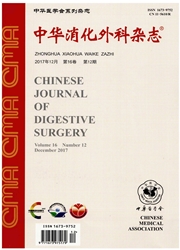

 中文摘要:
中文摘要:
目的探讨NO在肝硬化门静脉高压症血管收缩反应中发挥作用的机制,特别是NO与RhoA/ROCK通路问的相互作用机制。方法分别测定正常大鼠(正常对照组,5只)、CCl4诱导的肝硬化门静脉高压症大鼠(实验对照组,6只)和经L-NAME处理的门静脉高压症大鼠(L-NAME处理组,6只)外周血和肠系膜动脉NO含量;利用血管灌流系统测定上述3组大鼠肠系膜微动脉对去甲肾上腺素的反应;Westernblot分别检测3组大鼠肠系膜动脉NO-cGMP-PKG通路和RhoA/ROCK相关蛋白表达水平的变化。多组间均数比较采用单因素方差分析,两两比较采用LSD-t检验,肠系膜微动脉对去甲肾上腺素反应性的变化通过量.效曲线表示,运用非线性回归法,计算出EC50值。结果(1)正常对照组、实验对照组和L-NAME处理组大鼠平均门静脉压力分别为(6.2±0.9)mmHg(1mmHg=0.133kPa)、(13.9±1.7)mmHg和(16.6±1.3)mmHg,3组比较,差异有统计学意义(F=94.4,P〈0.05)。(2)正常对照组、实验对照组和L-NAME处理组大鼠平均血清NO浓度分别为(43±5)μmol/L、(82±16)μmol/L和(45±9)μmol/L,3组比较,差异有统计学意义(F=24.77,P〈0.05);L-NAME处理组大鼠平均NO浓度明显低于实验对照组(P〈0.05)。(3)正常对照组、实验对照组和L-NAME处理组大鼠肠系膜动脉平均NO含量分别为(236±41)μmol/g、(407±82)μmol/g和(216±42)μmol/g,3组比较,差异有统计学意义(F=20.29,P〈0.05);L-NAME处理组大鼠肠系膜动脉平均NO含量明显低于实验对照组(P〈0.05)。(4)与实验对照组大鼠比较,L-NAME处理组大鼠的离体肠系膜微动脉对去甲肾上腺素剂量反应曲线左移,但未达到正常对照组大鼠反应曲线水平,正常对照组、实验对照组和L-NAME处理组大鼠EC50分别为6.458×10-7mol、9.546×10-7mol和7.494×1
 英文摘要:
英文摘要:
Objective To investigate the mechanisms of nitric oxide (NO) in decreasing intestinal mesenterie arterial hypoeontraetility in rats with hepatic cirrhosis and portal hypertension, and to analyze the inter- action of NO and RhoA/ROCK pathway. Methods The levels of NO in the peripheral blood and mesenteric artery of normal rats (normal control group, 5 rats), rats with portal hypertension (experimental control group, 6 rats) and rats with portal hypertension treated by L-NAME (L-NAME group, 6 rats) were detected. Mesenteric arteriolecontractility to norepinephrine in the 3 groups was determined using a vessel perfusion system. The expressions of proteins of NO-cGMP-PKG pathway and RhoA/ROCK pathway in the 3 groups were detected by Western blot. All data were analyzed using the analysis of variance or LSD-t test. The changes of mesenteric arteriole contractility to norepinephrine was expressed in dose-response curve, and was analyzed using the nonlinear regression method, and the ECso value was calculated. Results ( 1 ) The pressures of portal veins of the normal control group, exper- imental control group and L-NAME group were (6.2 ± 0.9)mm Hg (1 mm Hg = 0. 133 kPa), (13.9 ± 1.7)mm Hg and ( 16.6 ± 1.3 )mm Hg, respectively, with a significant difference among the 3 groups ( F = 94.4, P 〈 0.05 ). (2) The levels of NO in the normal control group, experimental control group and L-NAME group were (43± 5)μmol/L, ( 82 ±16 ) μmol/L and ( 45 ± 9 ) μmol/L, respectively, with a significant difference among the 3 groups (F = 24. 77, P 〈 0.05 ). The level of NO of the L-NAME group was significantly lower than that of the experimental control group ( P 〈 0.05 ). ( 3 ) The levels of NO in the mesenteric artery of the normal control group, experimental control group and L-NAME group were (236 ± 41 )μmol/g, (407 ± 82)μmol/g and (216 ± 42) μmol/g, respectively, with a significant difference among the 3 groups ( F = 20. 29, P 〈 0.
 同期刊论文项目
同期刊论文项目
 同项目期刊论文
同项目期刊论文
 期刊信息
期刊信息
